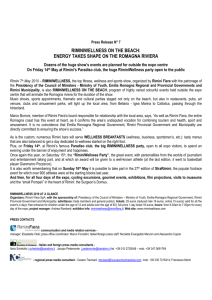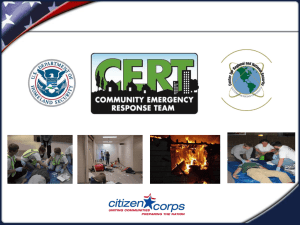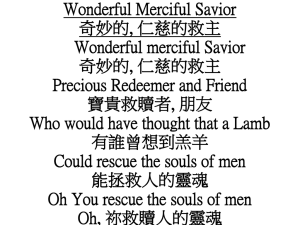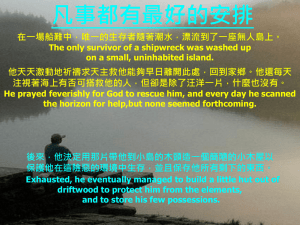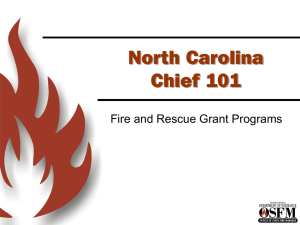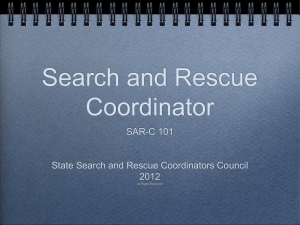Search and Rescue
advertisement
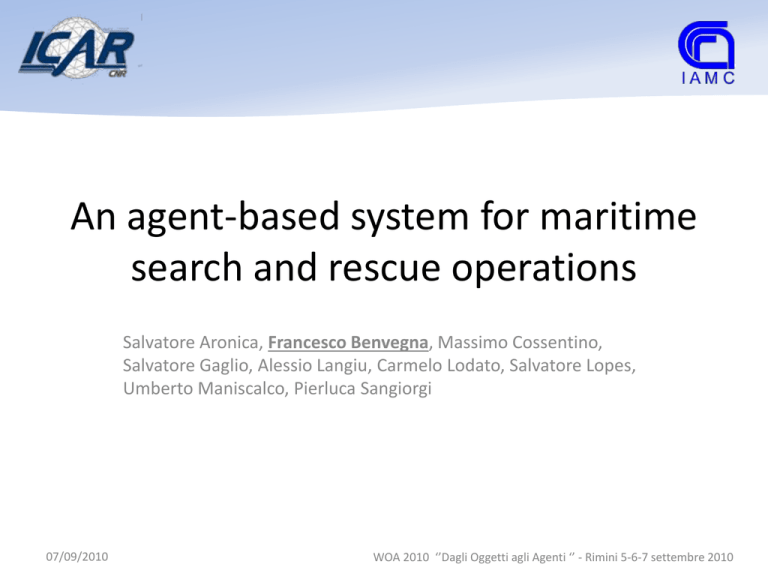
An agent-based system for maritime search and rescue operations Salvatore Aronica, Francesco Benvegna, Massimo Cossentino, Salvatore Gaglio, Alessio Langiu, Carmelo Lodato, Salvatore Lopes, Umberto Maniscalco, Pierluca Sangiorgi 07/09/2010 WOA 2010 ‘’Dagli Oggetti agli Agenti ‘’ - Rimini 5-6-7 settembre 2010 Outline • Introduction to search and rescue • The problem – Localization – Search and Rescue Operations • The proposed solution – System devices and technologies – Multi Agent System • Discussion and conclusions 07/09/2010 WOA 2010 - Rimini 5-6-7 settembre 2010 2 Introduction Coast Guards of all around the world are responsible for monitoring safety at sea and operate all the search and rescue (SAR) operations when someone is in danger Search and rescue operations usually originates from an explicit request for rescue A search plan is built based upon the last known position to cover an area 07/09/2010 WOA 2010 - Rimini 5-6-7 settembre 2010 3 Introduction “GOLDEN DAY ” only within the first 24 hours from the rescue request there are good chances of successfully accomplish the rescue 07/09/2010 WOA 2010 - Rimini 5-6-7 settembre 2010 4 Introduction Smaller ships used for recreation (e.g., sailing, diving, sport fishing, fishing, water skiing) are not always required to have radio stations installed but they may be so equipped by a choice. The major part of the recreation ships that sail between 6 and 50 marine miles far away from the coast, have just a voice marine VHF radio transmitter. a rescue request has to be done via voice on the emergency channel 07/09/2010 WOA 2010 - Rimini 5-6-7 settembre 2010 5 The problem Localization Search and Rescue • The time spent to localize a vessel plays a fundamental role in life saving. The less the time to discovery a vessel position, the more is the probability of saving human beings • Search and rescue Operations (SAROPs) in maritime environment are regulated by a series of procedures defined and approved at the worldwide level. 07/09/2010 WOA 2010 - Rimini 5-6-7 settembre 2010 6 The problem Localization Traditional techniques are based on radio communications between the boat in distress and the rescue service. While human beings need some time to communicate the vessel position by using the radio, an intelligent system could detect and localize the vessel in the sea by monitoring the radio channel activity The localization is possible due to at least two radio signal detections by two of the several stations deployed along the sea coast 07/09/2010 WOA 2010 - Rimini 5-6-7 settembre 2010 7 The problem Localization • The system normally listens to the maritime radio emergency channels and whenever a signal is detected, a search of possible matches is looked for • A triangulation is computed between the direction vectors detected by the two stations to locate the vessel 07/09/2010 WOA 2010 - Rimini 5-6-7 settembre 2010 8 The problem Search and Rescue Provide a computer aided system that covers all the procedures involved in maritime SAROPs and that is compliant to the guidelines provided by the IAMSAR The procedures involved in SAROPs can be grouped in two principal phases: – Determining datum – Define search action plan The search planner involved in the latter phase must define the optimal search area starting from the previously calculated datum and from some statistical considerations based on probability distributions 07/09/2010 WOA 2010 - Rimini 5-6-7 settembre 2010 9 The problem Search and Rescue Probability density for point, line and area datum (from IAMSAR manual, vol. II) 07/09/2010 Two examples of possible search paths (from IAMSAR manual, vol.II) WOA 2010 - Rimini 5-6-7 settembre 2010 10 The proposed solution We propose an integrated aiding system that is able to: • localize and visualize the requesting vessel position • estimate and visualize the search plan for the search operators and the operation coordinator • allow to visually follow all the SAR operations 07/09/2010 WOA 2010 - Rimini 5-6-7 settembre 2010 11 The proposed solution System Devices and Technologies The hardware architecture will comprise all the needed devices to work in marine radio environment both for detection and communication 07/09/2010 Detection Finder (RDF) Global Positioning System (GPS) Computer Network Device WOA 2010 - Rimini 5-6-7 settembre 2010 12 The proposed solution System Devices and Technologies 07/09/2010 WOA 2010 - Rimini 5-6-7 settembre 2010 13 The proposed solution The Multi Agent System The intelligent system is composed by a society of intelligent agents which collaborate in monitoring radio frequencies, in matching the detections, in notifying every rescue request to the rescue service operator. The software solution has been designed by using the PASSI design process and its evolution PASSI2. The multi-agent system has been implemented by using the JADE agent framework. 07/09/2010 WOA 2010 - Rimini 5-6-7 settembre 2010 14 The proposed solution The Multi Agent System • collects NMEA data from a detection finder and GPS device connected to the station • manages a data buffer to send to other agents • providing a search action plan for the • is the nearest•to responsible the human user for determining the datum for search objects starting from the datum • has a GUI with athe GIS search supporttargets to show the state of the system to the operator to by which the • computes the drift and forces interact with her/him searched objects are affected • designed to solve• a plots project radio- relative to the datum and therisk: information communication• inproduces very efficient way search action plan on GIS system the official papery worksheets defined in the IAMSAR manual • this agent is the receiving agent which is • coupled with the agent ’Send Data’ • collects the detected signals and stores described above them • finds any match inside to estimate the source of the radio signal 07/09/2010 WOA 2010 - Rimini 5-6-7 settembre 2010 15 The proposed solution The Multi Agent System The User Interface is based on the open source GIS platform “OpenMap” that allows to easily visualize geographical coordinates for points, shapes or lines on a geographic map. This GUI was designed according to the guidelines of the domain specialist working with the Coast Guard 07/09/2010 WOA 2010 - Rimini 5-6-7 settembre 2010 16 The proposed solution The Multi Agent System 07/09/2010 WOA 2010 - Rimini 5-6-7 settembre 2010 17 Discussion The problem we are studying is in our opinion a good example of ideal application context for multi-agent systems. This is due to the some specific requirements it has to fulfill: – autonomy of components – scalability – distribution – openness 07/09/2010 WOA 2010 - Rimini 5-6-7 settembre 2010 18 Discussion Autonomy of components and Scalability Each station should be autonomous and independent from other stations so that a failure (and resume) in one station does not seriously affect the system functionalities. The adoption of a MAS easily permits to scale the number of installed stations without any significant change to the system architecture to permits a wide installation to cover large regions as well as a small initial deploy 07/09/2010 WOA 2010 - Rimini 5-6-7 settembre 2010 19 Discussion Distribution and Openness The easiness of agents distribution (together with their autonomous behavior) permits the installation in some of the stations of only a part of the system that is duplicated in some others. The system is supposed to be in operation for a long period and it should be able to accept new functionalities by dynamically introducing new agents in the society 07/09/2010 WOA 2010 - Rimini 5-6-7 settembre 2010 20 Project Scheduling Now 95% of software development level, testing on laboratory 15 September 2010 installation at land Coast Guard Station, rescue vehicles and first sea test with distress simulation 30 October 2010 final delivery of the system 07/09/2010 WOA 2010 - Rimini 5-6-7 settembre 2010 21 Conclusions Maritime search and rescue operations are critical missions involving personnel, boats, helicopters, aircrafts in a struggle against time often worsened by adversary sea and weather conditions. telecommunication and information systems may play a crucial role sometimes concurring to successfully accomplish the mission 07/09/2010 WOA 2010 - Rimini 5-6-7 settembre 2010 22 Thanks for your attention Questions ?? contact: francesco.benvegna@unipa.it 07/09/2010 WOA 2010 - Rimini 5-6-7 settembre 2010 23
